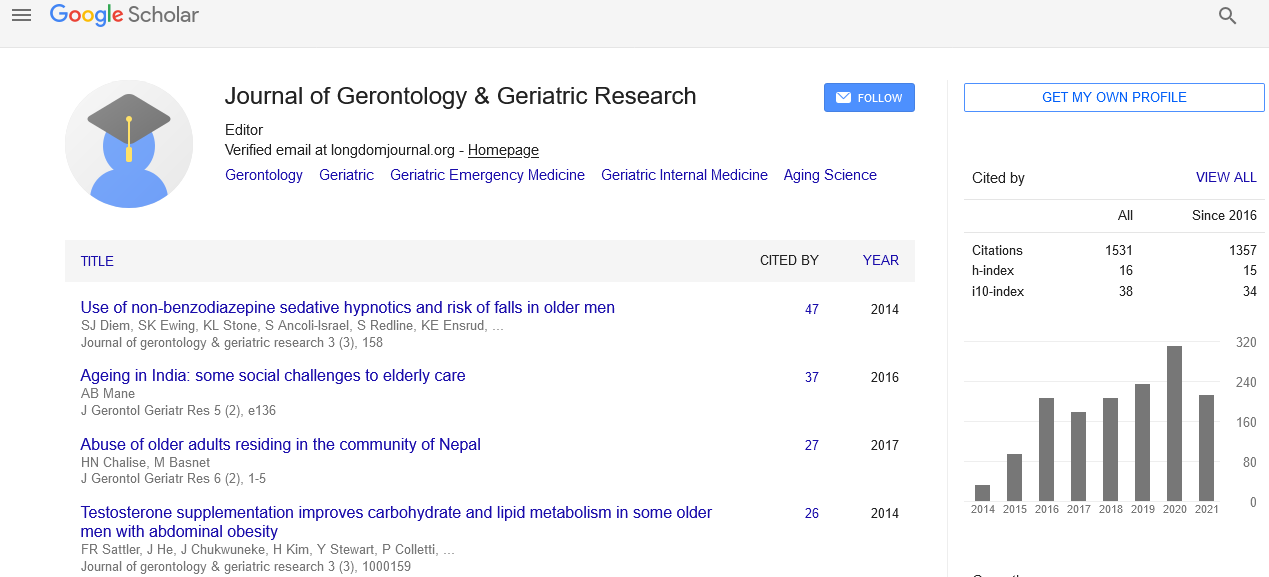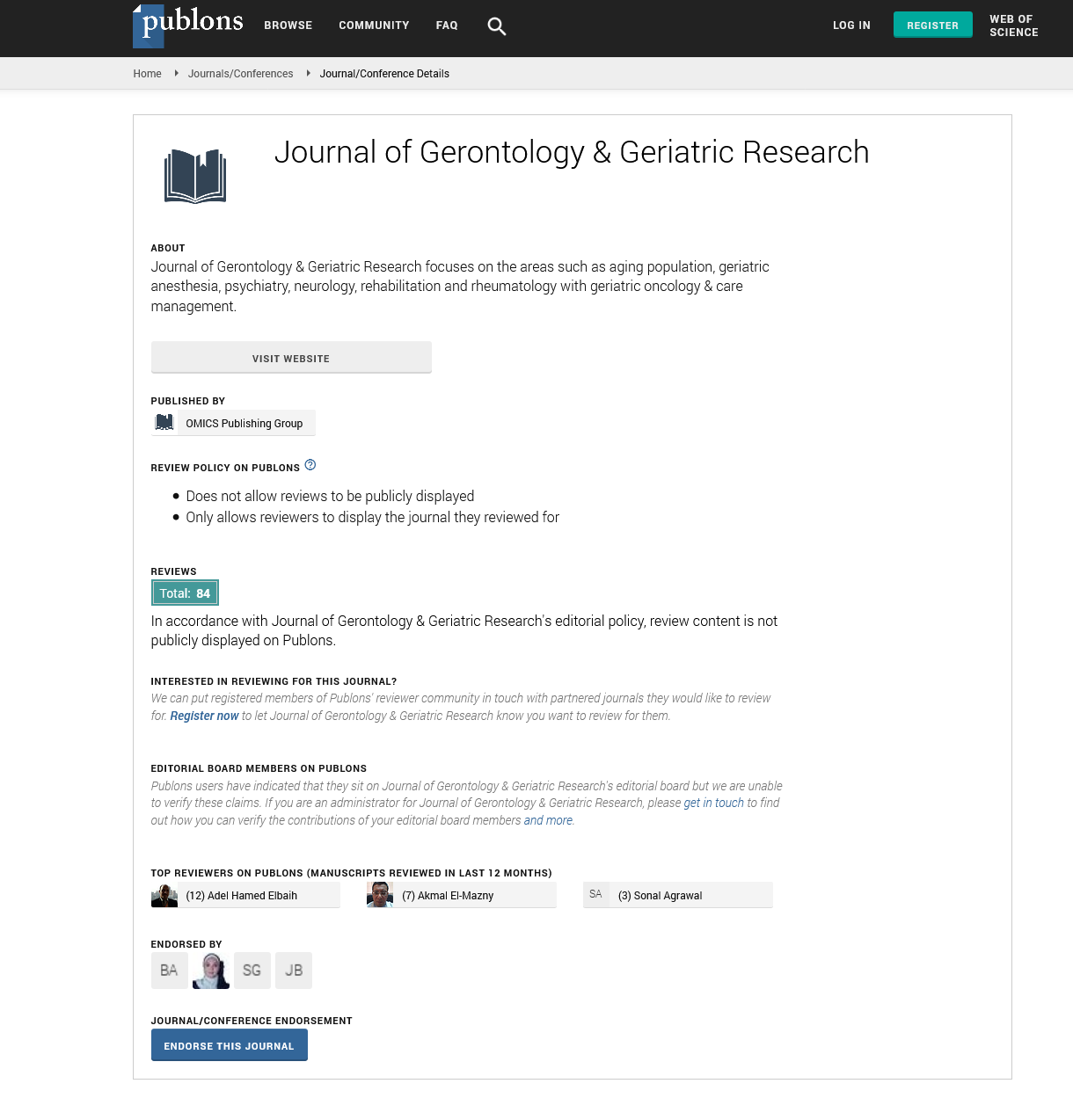PMC/PubMed Indexed Articles
Indexed In
- Open J Gate
- Genamics JournalSeek
- SafetyLit
- RefSeek
- Hamdard University
- EBSCO A-Z
- OCLC- WorldCat
- Publons
- Geneva Foundation for Medical Education and Research
- Euro Pub
- Google Scholar
Useful Links
Share This Page
Journal Flyer

Open Access Journals
- Agri and Aquaculture
- Biochemistry
- Bioinformatics & Systems Biology
- Business & Management
- Chemistry
- Clinical Sciences
- Engineering
- Food & Nutrition
- General Science
- Genetics & Molecular Biology
- Immunology & Microbiology
- Medical Sciences
- Neuroscience & Psychology
- Nursing & Health Care
- Pharmaceutical Sciences
Brief Report - (2022) Volume 11, Issue 3
Prevalence and Symptoms of Urinary Incontinence among Older Adults
Sen-Ju Yang*Received: 01-Mar-2022, Manuscript No. jggr -22-16482; Editor assigned: 03-Mar-2022, Pre QC No. P-16482; Reviewed: 17-Mar-2022, QC No. Q-16482; Revised: 21-Mar-2022, Manuscript No. R-16482; Published: 29-Mar-2022, DOI: 10.35248/2167-7182.22.11.603
Introduction
The rising prevalence of pelvic floor dysfunctions such as Urine Incontinence (UI) and pelvic organ prolapse is one of the health issues that must be addressed. According to a Japanese epidemiological survey of men and women over the age of 40, 41.7% had UI symptoms. Despite the fact that UI is common, many patients are hesitant to discuss their urinary symptoms or incontinence with their doctors. Functional dysfunction of the pelvic floor muscles is commonly the source of UI symptoms such as stress or urge UI. As a result, past research has indicated that pelvic floor muscle exercise and psychological counselling are effective treatments for UI symptoms.
About the Study
Urinary incontinence is an issue that affects many older adult women around the world. Female urinary incontinence is defined by the International Continence Society as involuntary urine leaking that is objectively detectable and causes social or sanitary hardship. Urinary incontinence affects 4% to 8% of the world's population, with 383 million people affected in 2013, according to figures adopted by the 6th International Consultation on Incontinence. Urinary incontinence affects 15-30% of women in the community, and studies have shown that it worsens with age, owing to age-related changes in the urinary system, such as organ mucosal atrophy, changes in bladder volume, and bladder neck hypermobility [1-3].
Urinary incontinence is divided into three types: Stress Urinary Incontinence (SUI), which accounts for about 51% of total urinary incontinence; Urgency Urinary Incontinence (UUI), which accounts for about 10% of total urinary incontinence; and Mixed Urinary Incontinence (MUI), which accounts for about 39% of total urinary incontinence. SUI occurs when stomach pressure rises without a need to void (during physical activities such as coughing, sneezing, laughing, sprinting and leaping, heavy-lifting, or descending stairs). UUI denotes urine leakage that occurs before reaching the toilet when there is a need to void, and is caused by bladder muscular spasm or overactive bladder, with the underlying causes in most cases unknown; and MUI denotes a combination of SUI and UUI.
Patients with urine incontinence have a variety of symptoms and illness progression rates. As a result, a comprehensive rehabilitation programme employs various combinations of conservative treatments based on patients' actual clinical situations, and various treatment models are created to meet the needs of specific patients. Electrical stimulation is advised for patients with more severe illnesses who are unable to undergo active PFM training. Biofeedback therapy is frequently used to give appropriate training and develop endurance in patients with milder diseases or those who show improvement during the treatment process. All patients will receive exercise therapy as parts of their treatment to assist strengthen their PFM and build the habit of self-training at home. To assess the results, previous studies have largely focused on SUI or a single therapy intervention. The purpose of this study is to look into the efficacy of a comprehensive rehabilitation programme for women with urine incontinence that includes biofeedback, IES, and exercise therapy.
UI is a prevalent condition that has a substantial negative impact on a patient's Quality of Life (QoL) and is one of the variables that puts a significant strain on family caregivers. connection between UI symptoms, Health-related Quality of Life (HRQoL), and Subjective Well-being (SWB) in women with UI aged 45–60 years; UI symptoms do not directly affect SWB, but symptoms affect HRQoL, which may contribute to a deterioration in SWB [4,5].
Conclusion
Older persons discharged from the hospital, UI was associated with age, diabetes mellitus, reduced physical activity, decreased HRQoL, and decreased SWB, and that decreased mental health status was strongly connected with UI. Many patients are hesitant to talk about UI, resulting in unresolved medical, functional, and psychological morbidities, as well as a lower quality of life. Many studies have found a link between UI severity and mental health in people who suffer it. The majority of UI patients believe that incontinence is a normal part of ageing and that there is no obvious management strategy or treatment. As a result, people with UI often embarrassed to tell their family members or health care providers about their urine incontinence symptoms. As a result, health-care providers should urge seniors to inquire about UI. Increased education of UI as an illness is needed to equip older persons with accurate information and treatment alternatives.
Conflicts of Interest
The authors declare no conflict of interest.
REFERENCES
- Fornell UE, Wingren G, Kjølhede P. Factors associated with pelvic floor dysfunction with emphasis on urinary and fecal incontinence and genital prolapse: An epidemiological study. Acta Obstet Gynecol Scand. 2004;83:383-389.
- Ogrinc UB, Sencar S, Lenasi H. Novel minimally invasive laser treatment of urinary incontinence in women. Lasers Surg Med. 2015;47:689-697.
- Aoki Y, Brown HW, Brubaker L, Cornu JN, Daly JO, Cartwright R. Urinary incontinence in women. Nat Rev Dis Primers. 2017;3:17042.
- Mota RL, Ocidental ECHDL. Female urinary incontinence and sexuality. Int Braz J Urol. 2017;43:20-28.
- Gascon MRP, de Almeida Mellao M, Mello SH, Negrao RM, de Oliveira ACP. The impact of urinary incontinence on the quality of life and on the sexuality of patients with HAM/TSP. Braz J Infect Dis. 2018;22:288-293.
Google Scholar, Crossref, Indexed at
Google Scholar, Crossref, Indexed at
Google Scholar, Crossref, Indexed at
Google Scholar, Crossref, Indexed at
Citation: Yang SJ (2022) Prevalence and Symptoms of Urinary Incontinence among Older Adults. J Gerontol Geriatr Res. 11: 603.
Copyright: © 2022 Yang SJ. This is an open-access article distributed under the terms of the Creative Commons Attribution License, which permits unrestricted use, distribution, and reproduction in any medium, provided the original author and source are credited.


